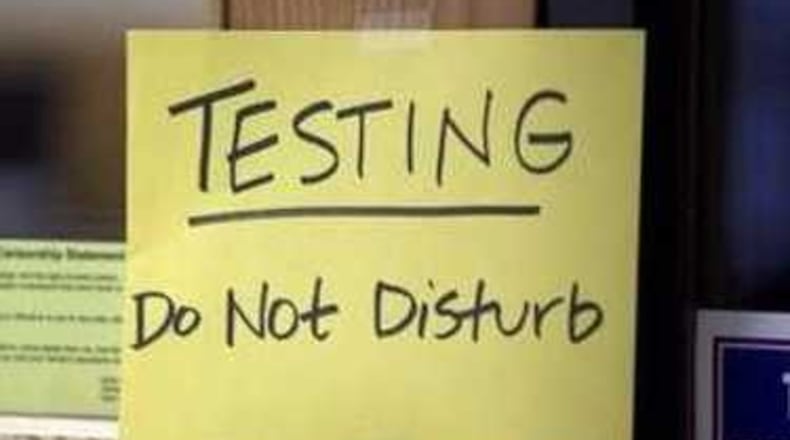In Dayton-area schools, districts that had scored higher in past years generally experienced smaller declines in their test performance index for 2020-21. And schools that scored lower in the past saw bigger drops.
“Before the pandemic, focusing on achievement gaps between students was obviously a big priority,” said Chris Woolard, ODE’s senior executive director for accountability and continuous improvement. “We see in many cases, those gaps have widened after last year.”
Local examples
Only six local school districts saw their “performance index percentage” drop by less than 5 points from the last round of state tests two years ago — Bethel, Tipp City, Cedar Cliff, Brookville, Oakwood and Newton.
Newton’s tiny 0.7-point drop was easily the area’s smallest, and all six of those districts had been among the area’s top one-third in test scores for 2018-19 (state tests were cancelled in 2019-20).
On the flip side, eight local school districts saw their performance index drop by at least 12 percentage points — Dayton, Trotwood, Jefferson Twp., Northridge, Huber Heights, Fairborn, Troy and Kettering. Six of those eight (all but Troy and Kettering) had been in the bottom one-third of local districts on the spring 2019 tests.
Statewide data
The 2020-21 state report cards do not include letter grades or year-over-year growth comparisons in this COVID-affected year.
Across Ohio, performance index percentage dropped by just over 10 points. ODE officials said students with disabilities, students of color and students from economically disadvantaged backgrounds experienced the greatest decreases.
The percentage of all students statewide who tested proficient or better on state exams declined 7.6% in English (from 64.6 to 57.0), and declined 12.8% in math (from 61.0% to 48.2%) from spring 2019. But economically disadvantaged students and Black students saw declines of 10% in English and 15% in math.
“We also know that districts that were mostly remote last year tended to see bigger decreases (in scores),” Woolard said.
Statewide, 24% of students were chronically absent in 2020-21, up from 16.7% in 2018-19, according to ODE. A student who misses 10% or more of the school year — roughly equivalent to two days a month — is considered chronically absent.
Among districts that primarily did remote learning during the 2020-21, chronic absenteeism increased by an average of 9 percentage points, while primarily in-person districts averaged 5-point increases.
Local high points
** Tests: Oakwood ranked 12th among the state’s 607 school districts in performance index, a detailed measure of state test score performance. Two smaller districts, Newton in Miami County and Waynesville in Warren County, were next locally, ranking around 40th.
A group of rural school districts just north of the Dayton area scored extremely well, with Marion Local and Fort Loramie posting the second- and third-highest test indexes in the state.
** Graduation: Less than 5% of school districts statewide had 100% of their high school class of 2020 graduate in four years. Locally, Miami East, Twin Valley South and Franklin-Monroe were among the 100% districts, while Brookville and Oakwood sat at 99%.
Statewide, the Class of 2020 had a four-year graduation rate of 87.2%, up from 85.9% the year before (graduation is reported on a one-year lag). The state legislature gave schools some flexibility as spring 2020 was affected by COVID school shutdowns.
** Attendance / absence: Again, several small rural districts outside of Dayton had among the state’s lowest chronic absenteeism rates (Russia, Marion Local, New Bremen and Franklin-Monroe). In the core Dayton area, Bellbrook (4.2%), Kettering (5.1%) and Springboro (5.8%) reported the lowest rates.
** Young readers: Waynesville ranked ninth among 607 Ohio school districts in the K-3 reading improvement measure, which tracks efforts at getting struggling young readers on track to proficiency by the third grade. Oakwood, Cedarville and Covington also ranked in the top 5% of the state on that measure.
** High school metrics: Oakwood and Russia were among the top 10 in the state on the Prepared for Success category, which tracks college entrance tests, honors diplomas, college credits and job credentials as a measure of college and career readiness. Springboro also scored among the top 5% of Ohio districts in that area.
Lower results
Dayton, Trotwood and Jefferson Twp. were the three lowest-scoring school districts locally for performance index on state tests, and were among the bottom 10 statewide, but they scored higher than the Akron, Youngstown and Cleveland districts.
Those same three districts were among the bottom five statewide in the Prepared for Success category and the bottom 20 in four-year graduation rate. Northridge schools also ranked in the bottom 5% of the state’s districts in multiple categories.
Northridge, Dayton and Trotwood also rank among the bottom 3% in the state for average income, continuing a years-long trend of report card scores mirroring community wealth statistics.
Outside of those districts, the only local schools to rank among the bottom 5% of the state in any category came in the K-3 reading improvement measure. Yellow Springs, Tri-County North and Miamisburg all ranked low for their performance in that area.
About the Author

